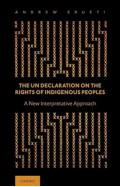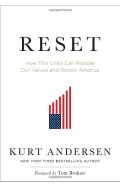- Home
- Books
- Categories
- Fiction
- The Un Declaration on the Rights of Indigenous Peoples - A New Interpretative Approach
The Un Declaration on the Rights of Indigenous Peoples - A New Interpretative Approach
By: Andrew Erueti
-
Rs 5,395.50
- Rs 5,995.00
- 10%
You save Rs 599.50.
Due to constant currency fluctuation, prices are subject to change with or without notice.
The current orthodoxy is to read the Declaration as containing human rights adapted to the indigenous situation. However, this reading does not do full justice to the complexity and diversity of indigenous peoples' participation in the Declaration negotiations. Instead, the book argues that the Declaration should be subject to a novel, mixed-model reading that views the Declaration as embodying two distinct normative strands that serve different types of indigenous peoples. Not only is this model supported by the Declaration's political history and legal argument, it provides a new and compelling theory of the bases of international indigenous rights while clarifying the vexed question of who qualifies as indigenous for the purposes of international law.
The current orthodoxy is to read the Declaration as containing human rights adapted to the indigenous situation. However, this reading does not do full justice to the complexity and diversity of indigenous peoples' participation in the Declaration negotiations. Instead, the book argues that the Declaration should be subject to a novel, mixed-model reading that views the Declaration as embodying two distinct normative strands that serve different types of indigenous peoples. Not only is this model supported by the Declaration's political history and legal argument, it provides a new and compelling theory of the bases of international indigenous rights while clarifying the vexed question of who qualifies as indigenous for the purposes of international law.
The Un Declaration on the Rights of Indigenous Peoples - A New Interpretative Approach
By: Andrew Erueti
Rs 5,395.50 Rs 5,995.00 Ex Tax :Rs 5,395.50
Zubin Mehta: A Musical Journey (An Authorized Biography)
By: VOID - Bakhtiar K. Dadabhoy
Rs 892.50 Rs 1,050.00 Ex Tax :Rs 892.50
The Origins of Political Order From Prehuman Times to the French RevolutioN
By: Francis Fukuyama
Rs 4,045.50 Rs 4,495.00 Ex Tax :Rs 4,045.50
Reset: How This Crisis Can Restore Our Values and Renew America
By: Kurt Andersen
Rs 450.00 Rs 500.00 Ex Tax :Rs 450.00
How To Win A Cosmic War God Globalization And The End Of War
By: Reza Aslan
Rs 625.50 Rs 695.00 Ex Tax :Rs 625.50
Game Change Obama And The Clintons McCain And Palin And The Race Of A Lifetime
By: John Heilemann
Rs 715.50 Rs 795.00 Ex Tax :Rs 715.50
Made to Stick: Why Some Ideas Take Hold and Others Come Unstuck
By: Chip Heath & Dan Heath
Rs 2,695.50 Rs 2,995.00 Ex Tax :Rs 2,695.50
No similar books from this author available at the moment.
Discover Biology Chemistry & Physics - A First Introduction to Science Encyclopedia of Learning
By: Martin Ellick
Rs 1,975.50 Rs 2,195.00 Ex Tax :Rs 1,975.50
You Only Live Once - Find Your Purpose. Make Life Count
By: Noor Hibbert
Rs 3,415.50 Rs 3,795.00 Ex Tax :Rs 3,415.50
In Search of Shiva: A Study of Folk Religious Practices in Pakistan
By: Haroon Khalid
Rs 675.75 Rs 795.00 Ex Tax :Rs 675.75
ME AND MY FEELINGS SQUARE BOARD BOOK - WHEN OWL FEELS SCARED
By: Krishna Kumar
Rs 1,255.50 Rs 1,395.00 Ex Tax :Rs 1,255.50
ME AND MY FEELINGS SQUARE BOARD BOOK - WHEN LION FEELS SHY
By: Krishna Kumar
Rs 1,255.50 Rs 1,395.00 Ex Tax :Rs 1,255.50
The Sum of Us - What Racism Costs Everyone and How We Can Prosper Together
By: Heather McGhe
Rs 1,610.75 Rs 1,895.00 Ex Tax :Rs 1,610.75
The Change Book: Fifty models to explain how things happen
By: Mikael Krogerus
Rs 2,965.50 Rs 3,295.00 Ex Tax :Rs 2,965.50
Zubin Mehta: A Musical Journey (An Authorized Biography)
By: VOID - Bakhtiar K. Dadabhoy
Rs 892.50 Rs 1,050.00 Ex Tax :Rs 892.50
The Un Declaration on the Rights of Indigenous Peoples - A New Interpretative Approach
By: Andrew Erueti
Rs 5,395.50 Rs 5,995.00 Ex Tax :Rs 5,395.50














-120x187.jpg?q6)





-120x187.jpg?q6)




















